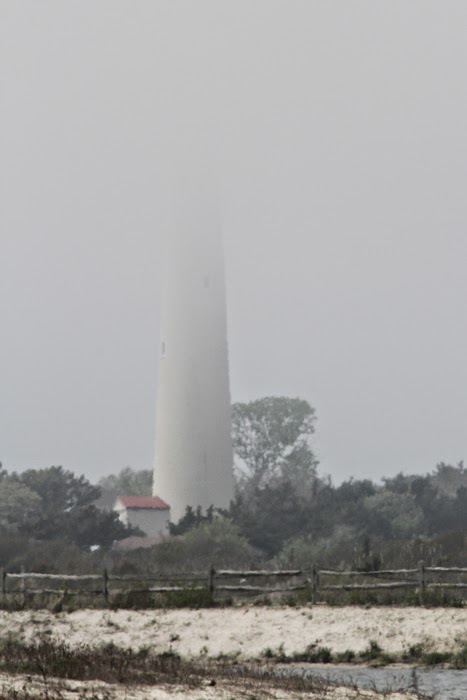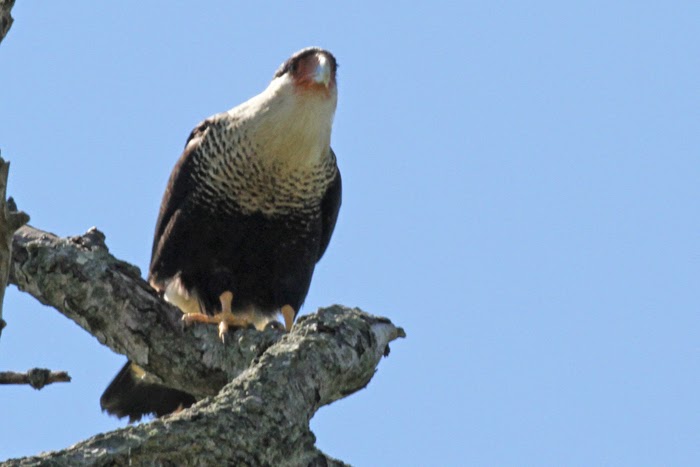As we pass imperceptibly into the second half of May, life becomes a little stressful for the dedicated Cape May birder. Why would this be? Well, impossible as it may seem, some of us are forced to venture over the canal bridge and head north to enjoy the region's best shorebird spectacular in - shock, horror - Cumberland County!! I am sure some are working away very hard behind the scenes to try to annex that little piece of land that lies east of the Maurice River and harbors the Heislerville Wildlife Management Area, for here is the spot that all self-respecting birders will want to be at during the second half of May.
On the east bank of the Maurice River and at the west end of Matt's Landing Road, Heislerville WMA has a cluster of three, non-tidal impoundments and in the second half of May at every high tide, the central impoundment provides a roosting area for large numbers of shorebirds, pushed off their feeding grounds by the rising waters of the Delaware Bay.
Not only does this area bristle with birdwatchers, it also bristles with researchers, for it is here that much of New Jersey Audubon's research into Semipalmated Sandpipers takes place - and the team will be more than happy to tell you about their work should you chance across them in their temporary work camp on the south side of the site.
On a first visit, Heislerville can seem very daunting; in front of you will lie a sea of brown and white, a great seething mass of totally confusing birds and not everyone's cup of tea. So here's a quick guide to the key species that can be expected at Heislerville at this time of year - of course, you can always come on a CMBO walk or workshop and benefit from the experience of our wonderful team of leaders, who will help you to get to grips with this interesting group of birds... we currently run Heislerville walks on Tuesdays and Thursdays through May.
Be sure to check the tide tables and aim to be at Heislerville around high tide, for it is then that birds are pushed off the intertidal flats and waves of birds (here mostly Dunlin and Short-billed Dowitchers) begin to arrive at the impoundment [photo by Mike Crewe].
As birds drop in to roost, we can begin to work through the flocks to see what has arrived. Here, a group of Semipalmated Sandpipers flies in [photo by Mike Crewe].
Once birds are on the ground, we can start to work through them - and the task may at first seem daunting! In this photo, seven species of shorebird share space on the beach at East Point, just around the corner from Heislerville [photo by Mike Crewe].
The commonest small 'peep' that you are likely to see at Heislerville in May is Semipalmated Sandpiper. This is overall a rather cold, gray-brown bird with just a touch of rust on the head. But with shorebirds, we should always look beyond the plumage and consider the structure; Semipalmateds are small, with short wings that just come to the tip of the tail. The bill can be confusing as the length varies - we can deduce that this bird is probably a male as the bill is particularly short. As this is the commonest species, we can consider it our yardstick, by which we can judge other species [photo by Mike Crewe].

Least Sandpipers are small, like Semipalmated Sandpipers but, at this time of year, are noticeably browner with rusty edges to the tertials (at the back of the wing). Most importantly, check the legs carefully and you will see that they are yellowish-green, not black. Least Sandpipers habitually feed on mud rather than in the water, even rooting around among the bases of plants growing around the edge of the impoundment [photo by Mike Crewe].
Stepping up a size, Dunlins are a little larger than the small 'peeps'. Dull gray-brown in winter, Dunlins really brighten up in breeding plumage and can be easily identified by their black belly patches and rich, rufous-brown backs. Note the relatively long, black and down-curved bill [photo by Mike Crewe].
While scanning through the Dunlins, look for a similar-sized bird with more subdued colors and a shorter bill that has a pale base. Note also the finely and very neatly-marked breast. If you are lucky, the bird might stretch a wing and you will see its white rump - this is a White-rumped Sandpiper. White-rumps are not common at Heislerville, but small numbers pass through in late May and should always be looked for at this time [photo by Mike Crewe].
Also a medium-sized shorebird, Semipalmated Plovers stand out among the crowd with their bold black and white head patterns, making them one of the easier shorebirds to identify. They are fun to watch at this time of year as they often squabble among themselves and the urge to breed also produces some interesting behavior! [Photo by Mike Crewe]

Largest of the commoner shorebirds to be found around Heislerville's muddy margins are the Short-billed Dowitchers. Though they always look rather dark overall at this time of year, this is a rather variable species, with males being more richly colored than females, and adults more richly colored than first-summer birds. Except for the dark brown back and tints of cinnamon below, it's best to leave plumage details in favor of structure to tell this bird from the other species present. Short-billed Dowitchers have olive-colored legs, long, black bills (despite the name) and are heavy-bodied. The very similar Long-billed Dowitcher may occur on occasion at Heislerville (perhaps one or two among the thousands of other shorebirds) but the vast majority of dowitchers here will be Short-billeds [photo by Mike Crewe].

Far less common in the impoundments and more likely in nearby marshes, Willets may occasionally be encountered among the shorebird masses. This is a typical Eastern Willet - relatively short- and heavy-billed, chunky overall and with plumage heavily blotched with black and dark brown. I mention this, because today we also saw the following at Heislerville...
...this bird is a Willet, yet it looks very unlike the bird above. This is a Western Willet and - rumor has it - the two forms may one day be considered separate species, so it's always good to get an eye in on them. Despite the name, Western Willets regularly pass down the East coast in fall, but May birds are decidedly unusual. Note the longer and slimmer bill compared with the Eastern Willet, the overall 'longer' look of the bird and the paler plumage [photos by Mike Crewe].
So, now that you have your eye in, here's one to test your powers of observation - what are the four birds lined up in the foreground. And yes, you may use your field guides! [Photo by Mike Crewe]
But it's not all doom and gloom for Cape May Pointers! The South Cape May Meadows continue to be managed well for migratory shorebirds and today attracted a Wilson's Phalarope (seen here on the left, with a Greater Yellowlegs on the right). Phalaropes habitually swim, which can be a useful identification guide, though Wilson's swims less than other phalarope species [photo by Mike Crewe].
Help our Researchers while enjoying your birding
Many of the World's shorebird populations are declining alarmingly and much research is going into studying these birds to see if we can reverse this worrying trend. You can help this research by keeping an eye out for banded birds and reporting your finds. If you see a marked bird, try to note the type (metal, plastic and or flag) and color of the band and note down any letters or numbers that might be visible on it. You can email us at Cape May Bird Observatory with your finds (please note date and location of the bird too) or you can visit
http://bandedbirds.org/ to learn more. You can enter the data for yourself and find out a lot about the bird by going directly to
http://report.bandedbirds.org/ReportResighting.aspx. We appreciate all the help you can give - and so do the birds...
I came across this flag-marked Ruddy Turnstone in my photos from East Point Lighthouse that I took on May 19th. The code 8HU can easily be read on this bird and serves as an unique identifier for researchers to be able to track the bird's movements - but tracking relies on birders to report their finds [photo by Mike Crewe].






























.JPG)






















